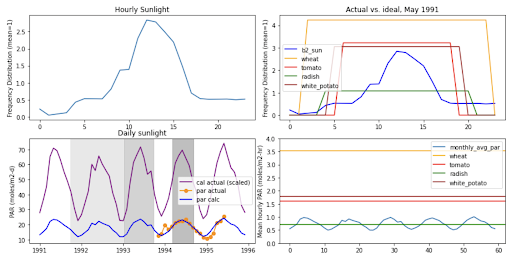by Grant Hawkins, lead developer for SIMOC B2 at Over the Sun, LLC
In mid-2022, our team took on the challenge of modeling Biosphere 2 (B2) in SIMOC. Beyond simply describing the outcomes and making sure that they match the published data, we also had to make sure that — The system and sub-systems responded correctly to changes in the configuration. When a user changes the area of sweet potatoes or the CO2 scrubber activation threshold, other agents are responding appropriately to those changes.
The sub-systems remain accurate on the original SIMOC validation data, the NASA CELSS growth-chamber experiments. There, plants were grown in highly-controlled environments in order to maximize their food productivity. For certain plants, the production rate in kg/m2-day was as much as 10x greater at CELSS than in Biosphere 2.
Light was found to be the biggest contributing factor to the differences in plant productivity. At CELSS, plants received constant-output electric lighting at an optimal level for an optimal number of hours per day. These ranged from 1.4 Mol/m2-h for 12 hours/day for rice, to 3.53 Mol/m2-h for 20 hours/day for wheat. At B2, the plants received whatever sunlight passed through the B2 windows and structural frame. Our approach was to use the CELSS data as the baseline for SIMOC plant consumption and production, and
The first step toward implementing SIMOC-B2 was to add a ‘light-response’ mechanism to the SIMOC plant agent. We added a new variable, ‘par_factor’, which scales the rate of biomass accumulation to the species-specific, hourly light requirement. The other functions of the plant (photosynthesis) are scaled to its total accumulated biomass, so the light response will be applied to those exchanges as well.
So this was a big step forward for the accuracy and flexibility of our plant growth model, but that wasn’t all. Some of the deeper changes to how exchange values are calculated led to a major reduction in memory footprint – more than 80% for simulations with more than one plant – which is great news for our cloud computing budget 🙂


